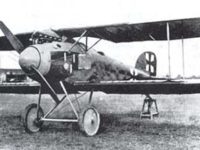The Albatros D.II should replace the rapidly developing and built Albatros D.I as a successor model. With some changes, the aircraft was produced from September 1916 and remained until mid-1917 the standard fighter aircraft of the German armed forces.
Development and construction:
Compared to the previous model, there were only two major changes. The first concerned the outward-spread center braces, which were used instead of the central bracing tower.
The second change was in the side cooler Windhoff, which was replaced by a Teeves & Braun wing cooler. This reduced the risk that the crash of the aircraft would occur if the cooler hit.
From September 1916 production could begin, whereby the air traffic society A.G. under license the aircraft for the German army and the Oesterreichische Flugzeugfabrik AG for the k.u.k. Troops produced.
Use in the First World War:
From October 1916, the Jagdstaffel 2 and the newly established Jagdstaffel 11 were equipped with the Albatros D.II aircraft. These should gradually replace the already used Fokker D.II aircraft and Halberstadt aircraft.
Due to the large number of aircraft produced, the Albatros D.II remained the standard fighter aircraft of the German army until mid-1917 and was able to regain air sovereignty over the western front for several months.
With the introduction of the Albatros D.III early 1917 and the Albatros D.II were gradually withdrawn from the front, but some machines remained until the end of the war in use.
Technical specifications:
| Designation: | Albatros D.II |
| Country: | German Empire |
| Typ: | Fighter plane |
| Length: | 7,33 meters |
| Span: | 8,5 meters |
| Height: | 2,64 meters |
| Mass: | 637kg empty |
| Crew: | Max. 1 |
| Engine: | Water-cooled 6-cylinder inline engine Mercedes D III with 160hp |
| Maximum speed: | 175 km/h |
| Reach: | 230 kilometers |
| Armament: | 2 x synchronized machine guns 7,92 mm LMG 08/15 |
You can find the right literature here:
Fokker Dr I Aces of World War 1 (Aircraft of the Aces)
Undoubtedly the most famous fighter type to see service on either side during World War 1, the Fokker Dr I was a revelation when it entered service on the western front in 1917. Manfred von Richthofens JG 1 circus was the first Jasta to completely re-equip with the new fighter, and in the skilled hands of its numerous aces the Dr I proved a formidable opponent. The Dr I remained in service on the Western Front until replaced by the superior Fokker D VII in May 1918. Just weeks prior to that, however, Germanys leading ace, the great Red Baron, had been killed at the controls of a Dr I.
Friedrichshafen Aircraft of WWI: A Centennial Perspective on Great War Airplanes (Great War Aviation) (Volume 21)

Friedrichshafen Aircraft of WWI: A Centennial Perspective on Great War Airplanes (Great War Aviation) (Volume 21) Paperback – February 16, 2016
This book describes and illustrates the development of Friedrichshafen aircraft of WWI with text, 540 photos, 18 in color, 37 color profiles, production quantities and serial numbers of aircraft, and aircraft dimensions and performance specifications. In addition, there are 26 official SVK drawings and 11 aircraft are illustrated in scale drawings to 1/48 (4) or 1/72 (7) scales. The book has 312 pages and is of interest to aviation historians, enthusiasts, and modelers alike.
German and Austro-Hungarian Aircraft Manufacturers 1908-1918
Much has been written about the British aircraft of the First World War, but little has surfaced about the aircraft of the Axis powers, Germany and Austria. Here, Terry C. Treadwell tells the story of the aircraft from companies such as Fokker, builder of the famous triplane, as fl own by Baron von Richthofen's Flying Circus, AEG, Albatros, Junkers and Hansa. From reconnaissance aircraft to state-of-the-art bombers that could reach London, this is the definitive guide to aircraft of the Axis powers during the First World War. The aircraft are explained in detail and a history of each company is provided, making this an excellent source book for aircraft enthusiasts, model makers and those interested in the air war over the trenches of France and Belgium, as well as further afield in the Italian campaign.
The Zeppelin in Combat: A History of the German Naval Airship Division
The standard reference now revised and expanded. Dr. Robinson has opened up his vast photo archives to enhance this new edition of his classic work. Much of the new photographic material is published here for the first time.
This post is also available in:
 Deutsch (German)
Deutsch (German)  Français (French)
Français (French)  Italiano (Italian)
Italiano (Italian)  简体中文 (Chinese (Simplified))
简体中文 (Chinese (Simplified))  Русский (Russian)
Русский (Russian)  Español (Spanish)
Español (Spanish)  العربية (Arabic)
العربية (Arabic)














